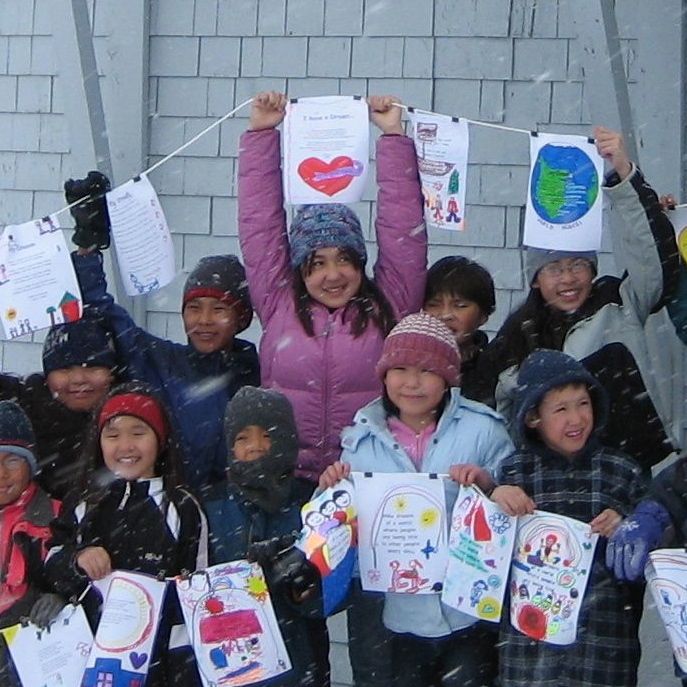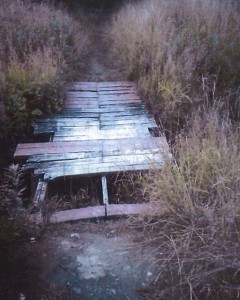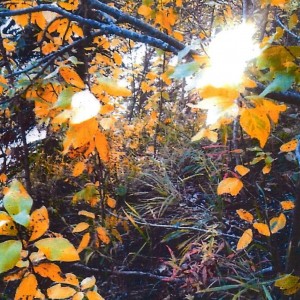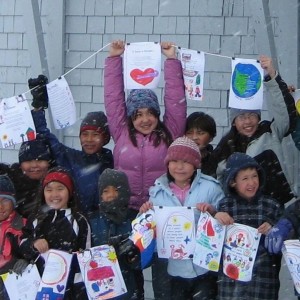Taking a Student Perspective: Lessons from Rayna
0May 14, 2014 by Sheri Skelton

 -by Sheri Skelton
English Teacher, White Mountain School, White Mountain, Alaska
M.A. 1997
-by Sheri Skelton
English Teacher, White Mountain School, White Mountain, Alaska
M.A. 1997
My Bread Loaf journey began in the summer of 1994 when I first traveled to Vermont from Shishmaref, a small Inupiaq village in northwestern rural Alaska. Summers at Bread Loaf provided academic challenges and conversations and the opportunity to focus on writing. More importantly, summers at Bread Loaf connected me to a powerful network of teachers and opened my eyes to the power of technology. My first computer was a Macintosh desktop on loan from Bread Loaf.
Twenty years later, I am still living and teaching in northwestern rural Alaska in a village that is one-third the size of Shishmaref. White Mountain, with a population of 200, lies along the Fish River. Teaching in a high school with an average of ten students is not without challenges. Instructing the same students several times per day for multiple years requires me to constantly create curriculum and devise and revise my pedagogical techniques and strategies.
Technology and network connections and interactions have been a tremendous help, but ultimately, my students are the ones who keep me engaged, particularly through their writing. Their ideas, their observations, and their words continue to intrigue me. I see things differently because of my students. I learn from them, and as a result, I become a more effective teacher.
Rayna is only one of many students who have involved me in looking at things from a different perspective. Following are a few quick looks at our journey together.
Making a Haiku Journey
In the 17th century, the pilgrim/poet Basho made a perilous journey on foot through the remote northeastern provinces of Japan. He recorded his five-month trek in a prose-poetry diary, writing many of his impressions in haikai, a poetic form that later evolved into haiku.
In the classroom, we discussed Basho and his poetic journey. We read excerpts from his diary and studied the haiku format. Then my students made their haiku journeys around White Mountain, selecting certain spots to photograph and write a companion haiku.
Following are four excerpts from Rayna’s journey, which she titled “Seeing Daylight.”
Forgotten, nameless A building without purpose Stands straight, regardless
There, invisible A few pieces of old wood Complete the small path
Big, metal monsters Soldiers standing in sunlight In their uniforms
Changing leaves are wise Their last wish is to watch the River keep flowing
Rayna’s haiku journey was insightful and reflective. She deviated from the popular spots one automatically thinks about when walking around White Mountain and selected areas within the village that were apparent but generally unnoticed. The journey she made provided me with a fresh perspective and prompted me to become more aware of my surroundings, to see things I normally passed without noticing. From Rayna I learned that a person can live years in a tiny place and still discover new aspects about that place.
Dreaming
My first encounter with Rayna and her dreams was on a snowy day in April when all the students at White Mountain School gathered outside to fly their dream flags. Rayna was ten years old and in the fifth grade. She was holding her dream flag high, arms outstretched, the pink heart on the flag symbolic of the truly kind person that she is.
The Dream Flag Project builds community through poetry and art. The project celebrates the poetry of Langston Hughes and draws from the tradition of Nepalese prayer flags to express good wishes. Students articulate their dreams via colorful illustrations and words on a flag that measures 11 x 8 ½ inches. A rope connects the flags and the dreams. The project began in 2003 as a sixth grade class assignment at the Agnes Irwin School in Rosemont, Pennsylvania. In 11 years, the Dream Flag Project has expanded to schools in 30 states and 18 countries, and more than 75,000 dreamers have flown their flags.
I became involved with dream flags after I published an article in The English Journal in 2006 about the place of poetry in the classroom. The article led to a connection with Jeff Harlan, English teacher and co-director of the Dream Flag Project. Every year since then, I have either worked with all of the students at White Mountain or just the ones in my classroom to create dream flags.
Rayna has shared her dreams in my classroom for the past four years. From Rayna I have learned to look for knowledge in the natural world. She writes, “Earth teach me to experience as the musk ox who is too old to move on,” or “Earth teach me to smile as the valleys of the mountains never frown.”
From Rayna I have learned to consider the possibilities. She writes, “I may be dreaming but wouldn’t it be great if laughter could be bottled up and prescribed to the sick,” or “I may be dreaming but wouldn’t it be great if lost people were just playing the best game of hide-and-seek?”
Each year the Dream Flag Project culminates with a major celebration in Philadelphia. This year the National Constitution Center was the site of the event. Technology allowed Rayna to attend the celebration and share her newest dream poem with a global audience. Following is a link to her video share.
Rayna graduates in May and will begin a journey away from the village of White Mountain. She plans to become an optometrist, a fitting career for someone with her extraordinary vision.
Category BLTN Teachers, Spring 2014 | Tags:




Leave a Reply